Change Management in SARHS Report 2022
VerifiedAdded on 2022/09/26
|18
|4539
|30
AI Summary
Contribute Materials
Your contribution can guide someone’s learning journey. Share your
documents today.
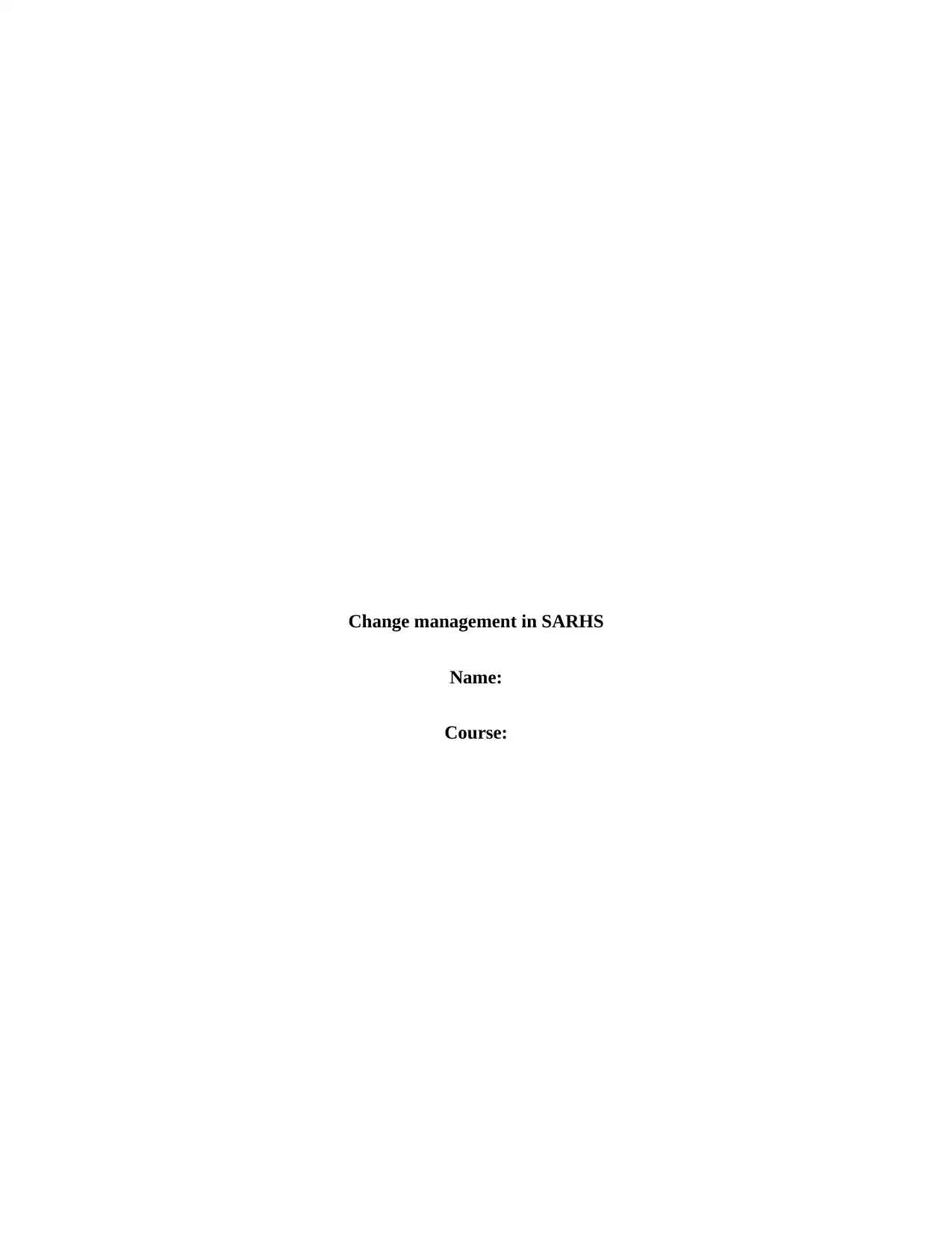
Change management in SARHS
Name:
Course:
Name:
Course:
Secure Best Marks with AI Grader
Need help grading? Try our AI Grader for instant feedback on your assignments.
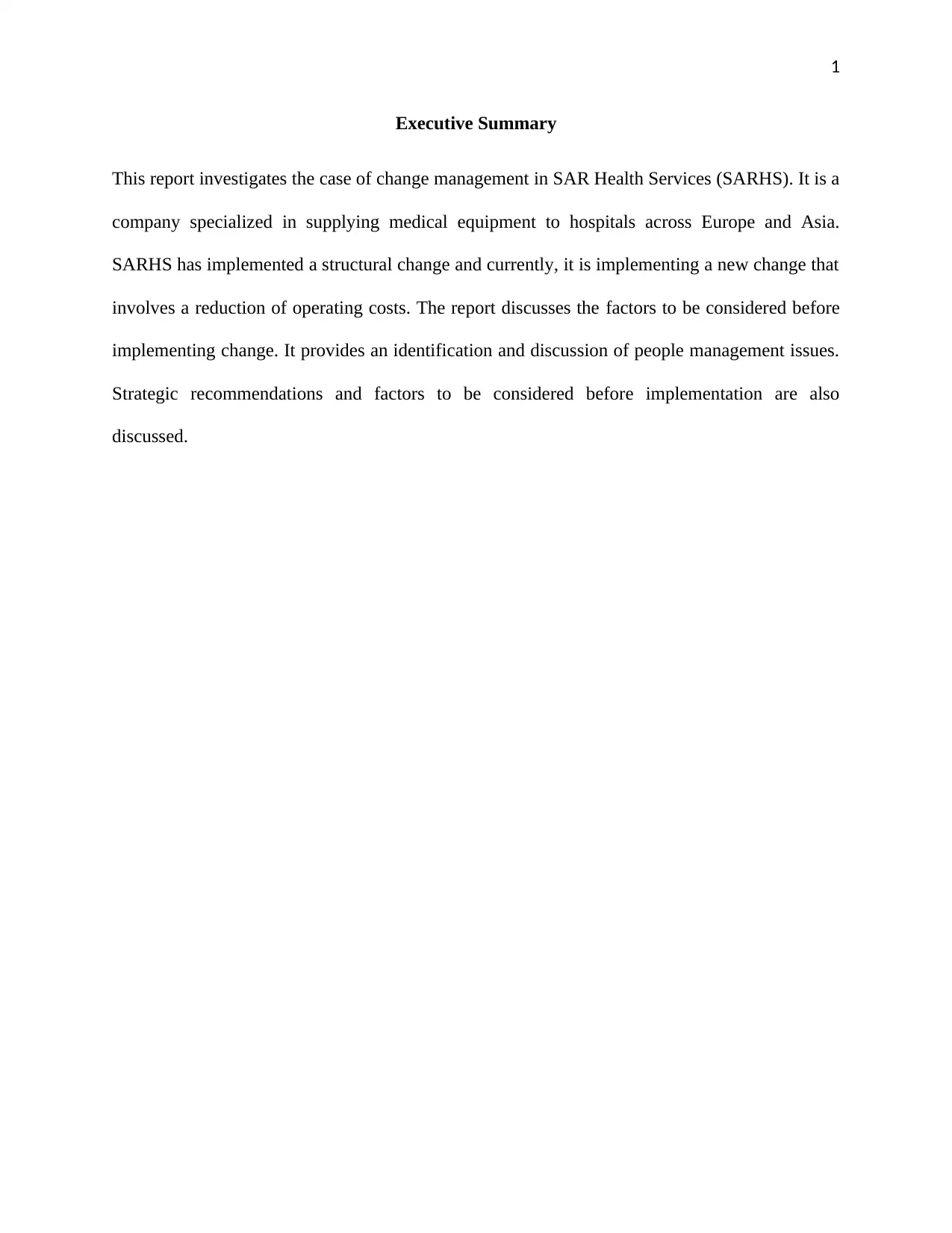
1
Executive Summary
This report investigates the case of change management in SAR Health Services (SARHS). It is a
company specialized in supplying medical equipment to hospitals across Europe and Asia.
SARHS has implemented a structural change and currently, it is implementing a new change that
involves a reduction of operating costs. The report discusses the factors to be considered before
implementing change. It provides an identification and discussion of people management issues.
Strategic recommendations and factors to be considered before implementation are also
discussed.
Executive Summary
This report investigates the case of change management in SAR Health Services (SARHS). It is a
company specialized in supplying medical equipment to hospitals across Europe and Asia.
SARHS has implemented a structural change and currently, it is implementing a new change that
involves a reduction of operating costs. The report discusses the factors to be considered before
implementing change. It provides an identification and discussion of people management issues.
Strategic recommendations and factors to be considered before implementation are also
discussed.
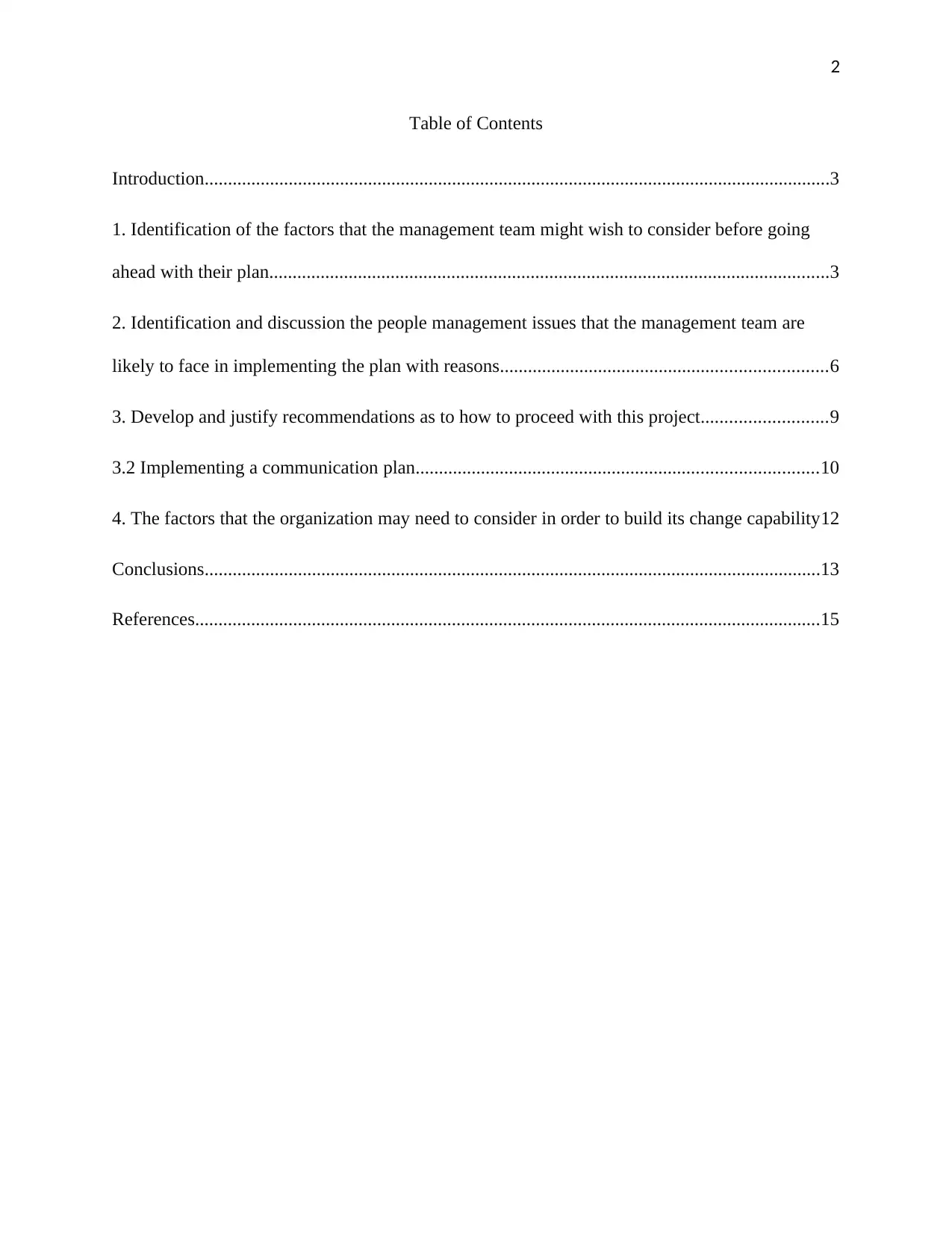
2
Table of Contents
Introduction......................................................................................................................................3
1. Identification of the factors that the management team might wish to consider before going
ahead with their plan........................................................................................................................3
2. Identification and discussion the people management issues that the management team are
likely to face in implementing the plan with reasons......................................................................6
3. Develop and justify recommendations as to how to proceed with this project...........................9
3.2 Implementing a communication plan......................................................................................10
4. The factors that the organization may need to consider in order to build its change capability12
Conclusions....................................................................................................................................13
References......................................................................................................................................15
Table of Contents
Introduction......................................................................................................................................3
1. Identification of the factors that the management team might wish to consider before going
ahead with their plan........................................................................................................................3
2. Identification and discussion the people management issues that the management team are
likely to face in implementing the plan with reasons......................................................................6
3. Develop and justify recommendations as to how to proceed with this project...........................9
3.2 Implementing a communication plan......................................................................................10
4. The factors that the organization may need to consider in order to build its change capability12
Conclusions....................................................................................................................................13
References......................................................................................................................................15
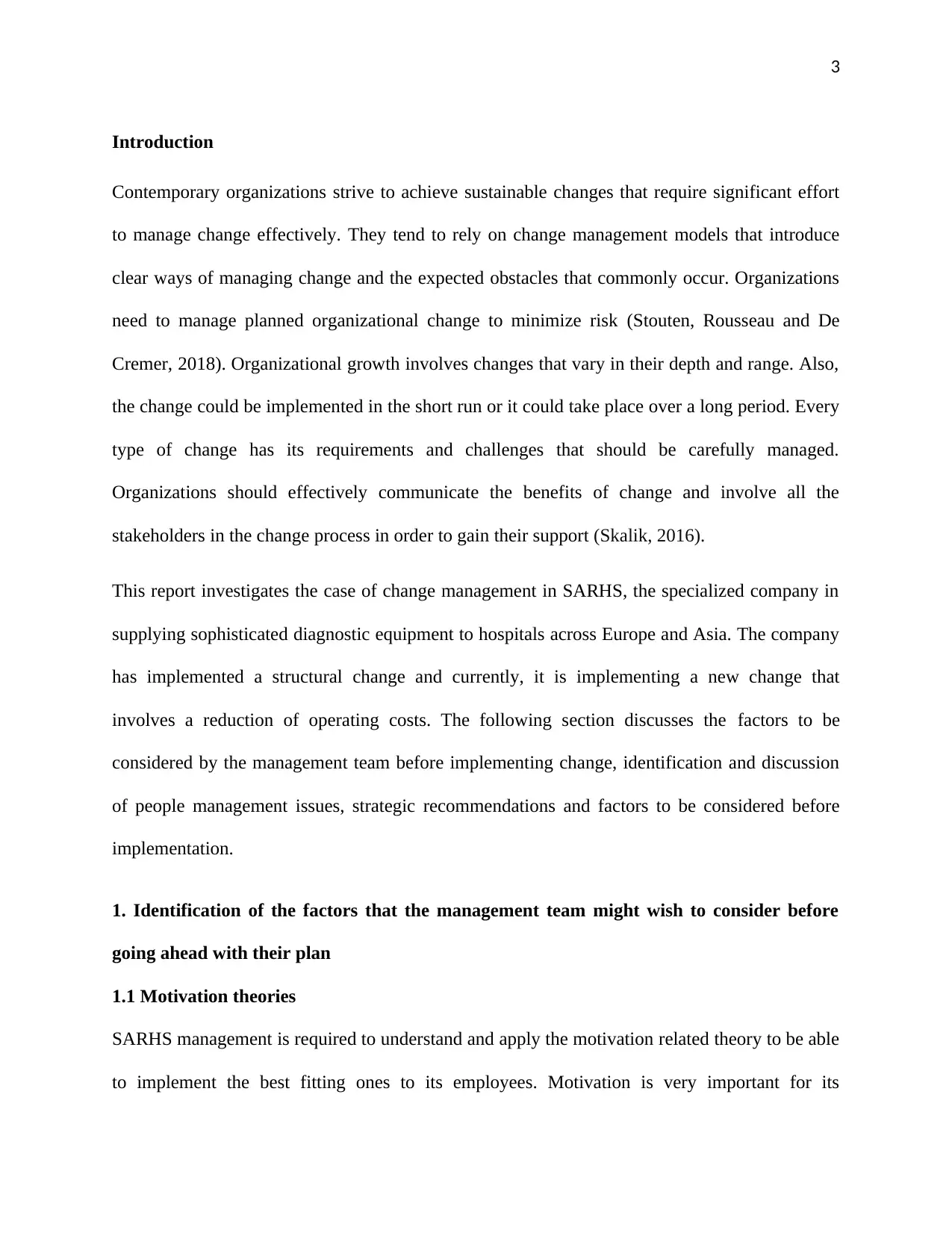
3
Introduction
Contemporary organizations strive to achieve sustainable changes that require significant effort
to manage change effectively. They tend to rely on change management models that introduce
clear ways of managing change and the expected obstacles that commonly occur. Organizations
need to manage planned organizational change to minimize risk (Stouten, Rousseau and De
Cremer, 2018). Organizational growth involves changes that vary in their depth and range. Also,
the change could be implemented in the short run or it could take place over a long period. Every
type of change has its requirements and challenges that should be carefully managed.
Organizations should effectively communicate the benefits of change and involve all the
stakeholders in the change process in order to gain their support (Skalik, 2016).
This report investigates the case of change management in SARHS, the specialized company in
supplying sophisticated diagnostic equipment to hospitals across Europe and Asia. The company
has implemented a structural change and currently, it is implementing a new change that
involves a reduction of operating costs. The following section discusses the factors to be
considered by the management team before implementing change, identification and discussion
of people management issues, strategic recommendations and factors to be considered before
implementation.
1. Identification of the factors that the management team might wish to consider before
going ahead with their plan
1.1 Motivation theories
SARHS management is required to understand and apply the motivation related theory to be able
to implement the best fitting ones to its employees. Motivation is very important for its
Introduction
Contemporary organizations strive to achieve sustainable changes that require significant effort
to manage change effectively. They tend to rely on change management models that introduce
clear ways of managing change and the expected obstacles that commonly occur. Organizations
need to manage planned organizational change to minimize risk (Stouten, Rousseau and De
Cremer, 2018). Organizational growth involves changes that vary in their depth and range. Also,
the change could be implemented in the short run or it could take place over a long period. Every
type of change has its requirements and challenges that should be carefully managed.
Organizations should effectively communicate the benefits of change and involve all the
stakeholders in the change process in order to gain their support (Skalik, 2016).
This report investigates the case of change management in SARHS, the specialized company in
supplying sophisticated diagnostic equipment to hospitals across Europe and Asia. The company
has implemented a structural change and currently, it is implementing a new change that
involves a reduction of operating costs. The following section discusses the factors to be
considered by the management team before implementing change, identification and discussion
of people management issues, strategic recommendations and factors to be considered before
implementation.
1. Identification of the factors that the management team might wish to consider before
going ahead with their plan
1.1 Motivation theories
SARHS management is required to understand and apply the motivation related theory to be able
to implement the best fitting ones to its employees. Motivation is very important for its
Secure Best Marks with AI Grader
Need help grading? Try our AI Grader for instant feedback on your assignments.
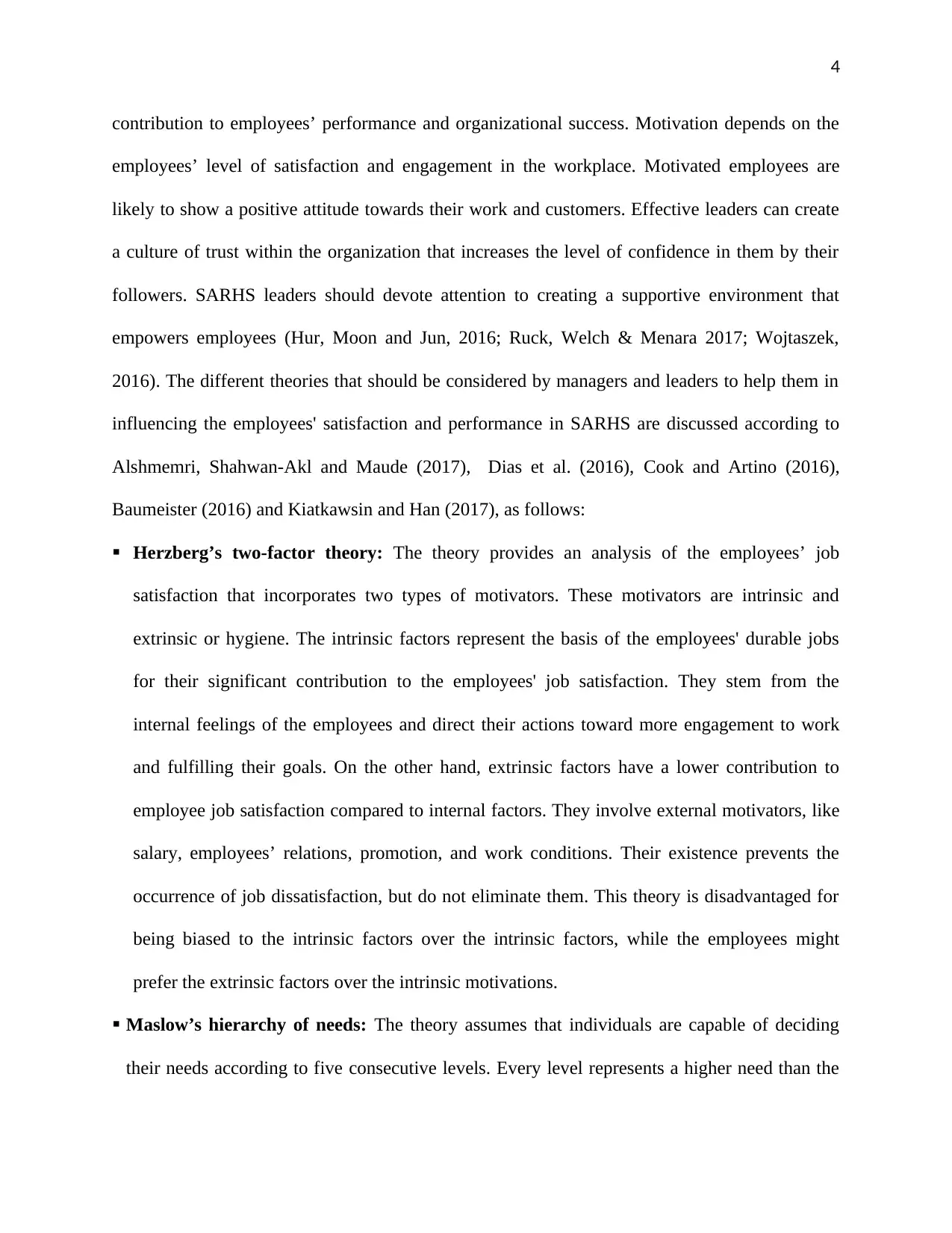
4
contribution to employees’ performance and organizational success. Motivation depends on the
employees’ level of satisfaction and engagement in the workplace. Motivated employees are
likely to show a positive attitude towards their work and customers. Effective leaders can create
a culture of trust within the organization that increases the level of confidence in them by their
followers. SARHS leaders should devote attention to creating a supportive environment that
empowers employees (Hur, Moon and Jun, 2016; Ruck, Welch & Menara 2017; Wojtaszek,
2016). The different theories that should be considered by managers and leaders to help them in
influencing the employees' satisfaction and performance in SARHS are discussed according to
Alshmemri, Shahwan-Akl and Maude (2017), Dias et al. (2016), Cook and Artino (2016),
Baumeister (2016) and Kiatkawsin and Han (2017), as follows:
Herzberg’s two-factor theory: The theory provides an analysis of the employees’ job
satisfaction that incorporates two types of motivators. These motivators are intrinsic and
extrinsic or hygiene. The intrinsic factors represent the basis of the employees' durable jobs
for their significant contribution to the employees' job satisfaction. They stem from the
internal feelings of the employees and direct their actions toward more engagement to work
and fulfilling their goals. On the other hand, extrinsic factors have a lower contribution to
employee job satisfaction compared to internal factors. They involve external motivators, like
salary, employees’ relations, promotion, and work conditions. Their existence prevents the
occurrence of job dissatisfaction, but do not eliminate them. This theory is disadvantaged for
being biased to the intrinsic factors over the intrinsic factors, while the employees might
prefer the extrinsic factors over the intrinsic motivations.
Maslow’s hierarchy of needs: The theory assumes that individuals are capable of deciding
their needs according to five consecutive levels. Every level represents a higher need than the
contribution to employees’ performance and organizational success. Motivation depends on the
employees’ level of satisfaction and engagement in the workplace. Motivated employees are
likely to show a positive attitude towards their work and customers. Effective leaders can create
a culture of trust within the organization that increases the level of confidence in them by their
followers. SARHS leaders should devote attention to creating a supportive environment that
empowers employees (Hur, Moon and Jun, 2016; Ruck, Welch & Menara 2017; Wojtaszek,
2016). The different theories that should be considered by managers and leaders to help them in
influencing the employees' satisfaction and performance in SARHS are discussed according to
Alshmemri, Shahwan-Akl and Maude (2017), Dias et al. (2016), Cook and Artino (2016),
Baumeister (2016) and Kiatkawsin and Han (2017), as follows:
Herzberg’s two-factor theory: The theory provides an analysis of the employees’ job
satisfaction that incorporates two types of motivators. These motivators are intrinsic and
extrinsic or hygiene. The intrinsic factors represent the basis of the employees' durable jobs
for their significant contribution to the employees' job satisfaction. They stem from the
internal feelings of the employees and direct their actions toward more engagement to work
and fulfilling their goals. On the other hand, extrinsic factors have a lower contribution to
employee job satisfaction compared to internal factors. They involve external motivators, like
salary, employees’ relations, promotion, and work conditions. Their existence prevents the
occurrence of job dissatisfaction, but do not eliminate them. This theory is disadvantaged for
being biased to the intrinsic factors over the intrinsic factors, while the employees might
prefer the extrinsic factors over the intrinsic motivations.
Maslow’s hierarchy of needs: The theory assumes that individuals are capable of deciding
their needs according to five consecutive levels. Every level represents a higher need than the
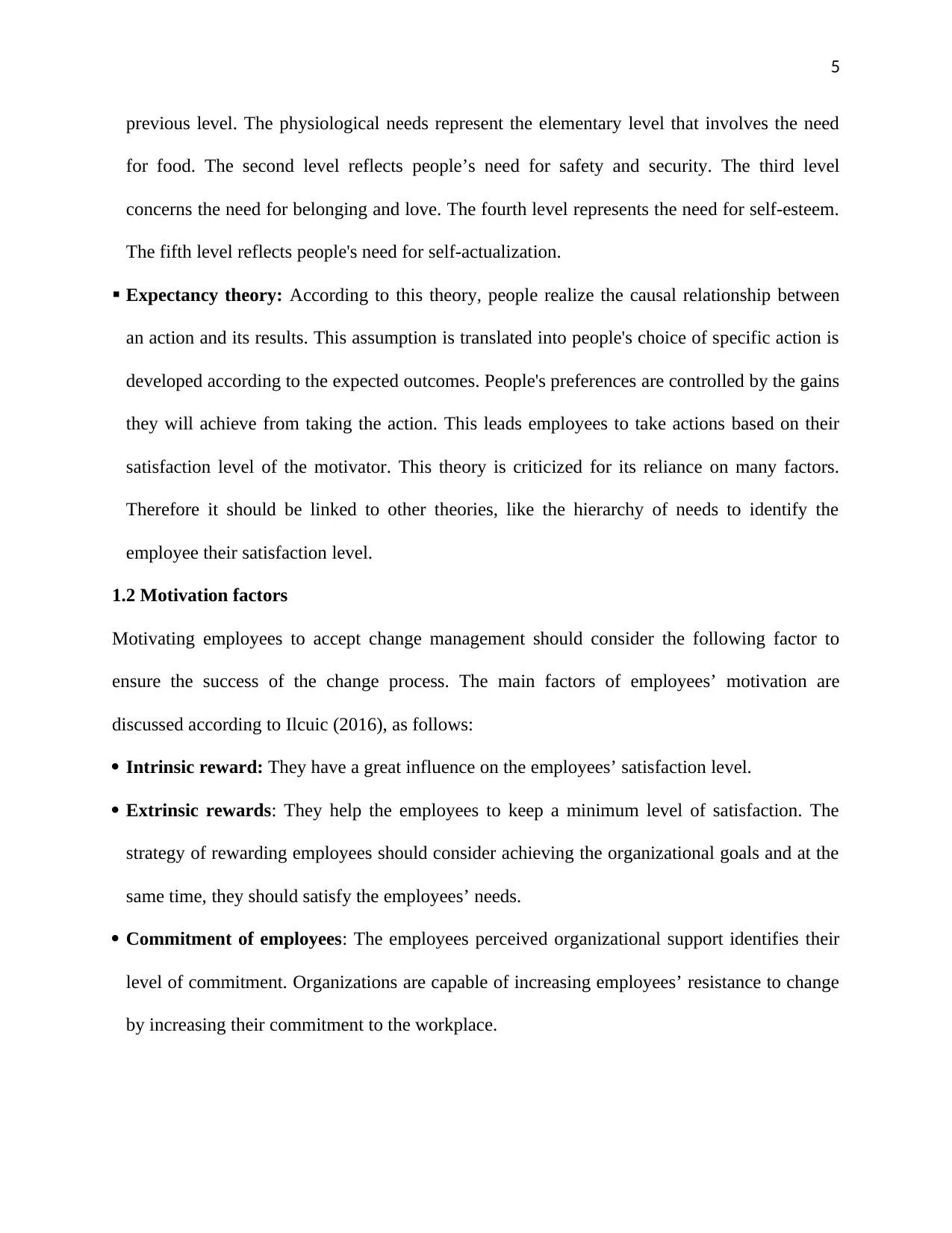
5
previous level. The physiological needs represent the elementary level that involves the need
for food. The second level reflects people’s need for safety and security. The third level
concerns the need for belonging and love. The fourth level represents the need for self-esteem.
The fifth level reflects people's need for self-actualization.
Expectancy theory: According to this theory, people realize the causal relationship between
an action and its results. This assumption is translated into people's choice of specific action is
developed according to the expected outcomes. People's preferences are controlled by the gains
they will achieve from taking the action. This leads employees to take actions based on their
satisfaction level of the motivator. This theory is criticized for its reliance on many factors.
Therefore it should be linked to other theories, like the hierarchy of needs to identify the
employee their satisfaction level.
1.2 Motivation factors
Motivating employees to accept change management should consider the following factor to
ensure the success of the change process. The main factors of employees’ motivation are
discussed according to Ilcuic (2016), as follows:
Intrinsic reward: They have a great influence on the employees’ satisfaction level.
Extrinsic rewards: They help the employees to keep a minimum level of satisfaction. The
strategy of rewarding employees should consider achieving the organizational goals and at the
same time, they should satisfy the employees’ needs.
Commitment of employees: The employees perceived organizational support identifies their
level of commitment. Organizations are capable of increasing employees’ resistance to change
by increasing their commitment to the workplace.
previous level. The physiological needs represent the elementary level that involves the need
for food. The second level reflects people’s need for safety and security. The third level
concerns the need for belonging and love. The fourth level represents the need for self-esteem.
The fifth level reflects people's need for self-actualization.
Expectancy theory: According to this theory, people realize the causal relationship between
an action and its results. This assumption is translated into people's choice of specific action is
developed according to the expected outcomes. People's preferences are controlled by the gains
they will achieve from taking the action. This leads employees to take actions based on their
satisfaction level of the motivator. This theory is criticized for its reliance on many factors.
Therefore it should be linked to other theories, like the hierarchy of needs to identify the
employee their satisfaction level.
1.2 Motivation factors
Motivating employees to accept change management should consider the following factor to
ensure the success of the change process. The main factors of employees’ motivation are
discussed according to Ilcuic (2016), as follows:
Intrinsic reward: They have a great influence on the employees’ satisfaction level.
Extrinsic rewards: They help the employees to keep a minimum level of satisfaction. The
strategy of rewarding employees should consider achieving the organizational goals and at the
same time, they should satisfy the employees’ needs.
Commitment of employees: The employees perceived organizational support identifies their
level of commitment. Organizations are capable of increasing employees’ resistance to change
by increasing their commitment to the workplace.
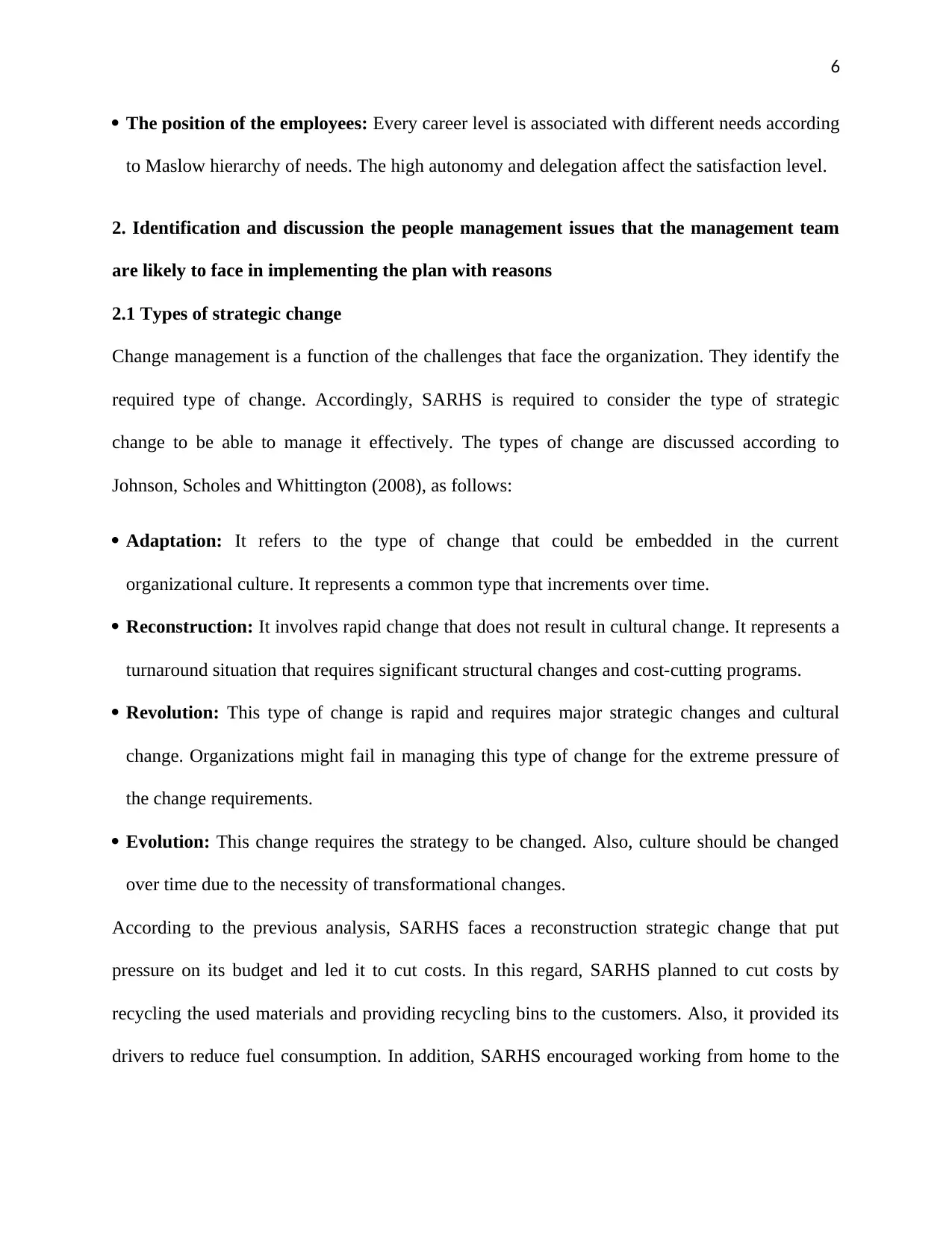
6
The position of the employees: Every career level is associated with different needs according
to Maslow hierarchy of needs. The high autonomy and delegation affect the satisfaction level.
2. Identification and discussion the people management issues that the management team
are likely to face in implementing the plan with reasons
2.1 Types of strategic change
Change management is a function of the challenges that face the organization. They identify the
required type of change. Accordingly, SARHS is required to consider the type of strategic
change to be able to manage it effectively. The types of change are discussed according to
Johnson, Scholes and Whittington (2008), as follows:
Adaptation: It refers to the type of change that could be embedded in the current
organizational culture. It represents a common type that increments over time.
Reconstruction: It involves rapid change that does not result in cultural change. It represents a
turnaround situation that requires significant structural changes and cost-cutting programs.
Revolution: This type of change is rapid and requires major strategic changes and cultural
change. Organizations might fail in managing this type of change for the extreme pressure of
the change requirements.
Evolution: This change requires the strategy to be changed. Also, culture should be changed
over time due to the necessity of transformational changes.
According to the previous analysis, SARHS faces a reconstruction strategic change that put
pressure on its budget and led it to cut costs. In this regard, SARHS planned to cut costs by
recycling the used materials and providing recycling bins to the customers. Also, it provided its
drivers to reduce fuel consumption. In addition, SARHS encouraged working from home to the
The position of the employees: Every career level is associated with different needs according
to Maslow hierarchy of needs. The high autonomy and delegation affect the satisfaction level.
2. Identification and discussion the people management issues that the management team
are likely to face in implementing the plan with reasons
2.1 Types of strategic change
Change management is a function of the challenges that face the organization. They identify the
required type of change. Accordingly, SARHS is required to consider the type of strategic
change to be able to manage it effectively. The types of change are discussed according to
Johnson, Scholes and Whittington (2008), as follows:
Adaptation: It refers to the type of change that could be embedded in the current
organizational culture. It represents a common type that increments over time.
Reconstruction: It involves rapid change that does not result in cultural change. It represents a
turnaround situation that requires significant structural changes and cost-cutting programs.
Revolution: This type of change is rapid and requires major strategic changes and cultural
change. Organizations might fail in managing this type of change for the extreme pressure of
the change requirements.
Evolution: This change requires the strategy to be changed. Also, culture should be changed
over time due to the necessity of transformational changes.
According to the previous analysis, SARHS faces a reconstruction strategic change that put
pressure on its budget and led it to cut costs. In this regard, SARHS planned to cut costs by
recycling the used materials and providing recycling bins to the customers. Also, it provided its
drivers to reduce fuel consumption. In addition, SARHS encouraged working from home to the
Paraphrase This Document
Need a fresh take? Get an instant paraphrase of this document with our AI Paraphraser
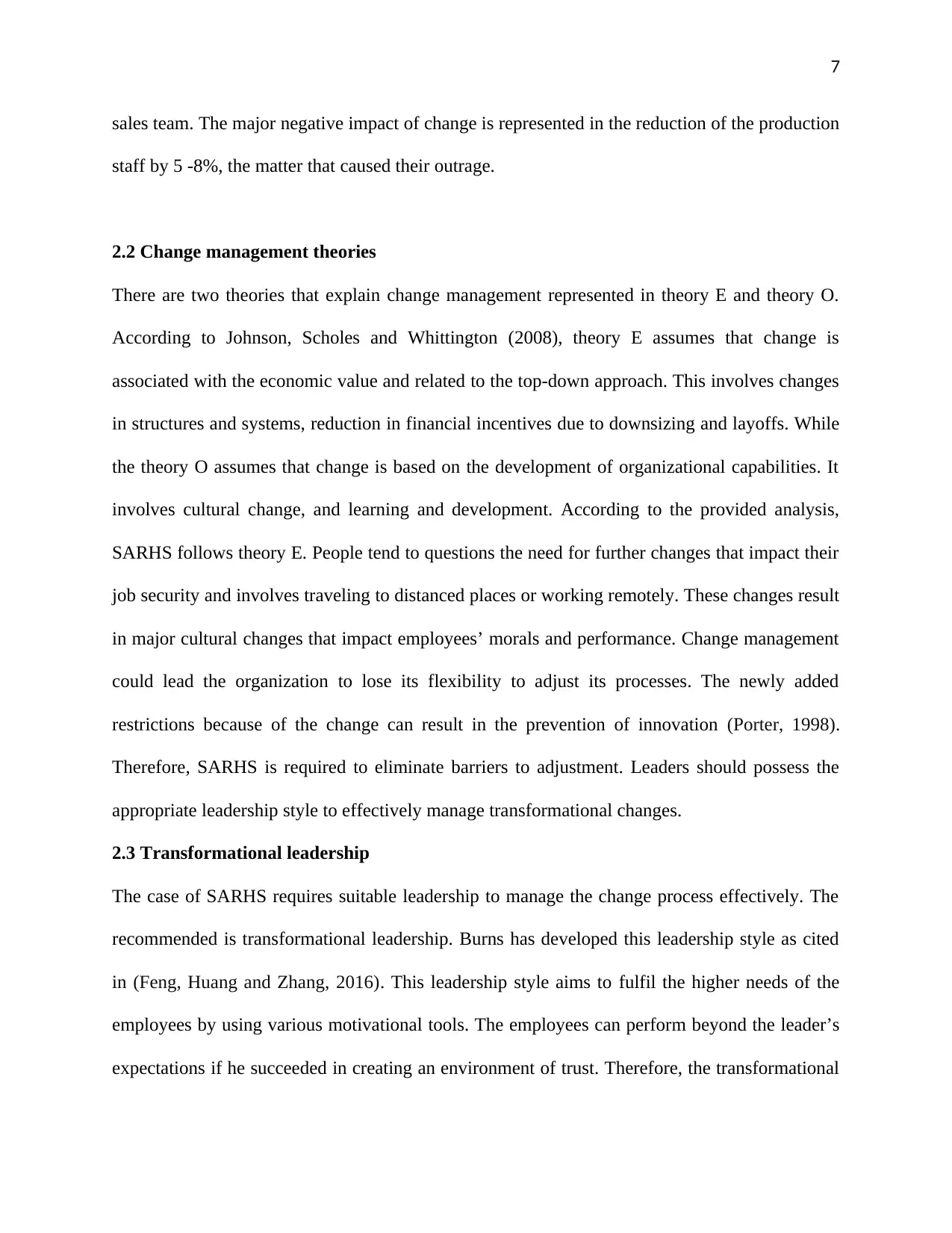
7
sales team. The major negative impact of change is represented in the reduction of the production
staff by 5 -8%, the matter that caused their outrage.
2.2 Change management theories
There are two theories that explain change management represented in theory E and theory O.
According to Johnson, Scholes and Whittington (2008), theory E assumes that change is
associated with the economic value and related to the top-down approach. This involves changes
in structures and systems, reduction in financial incentives due to downsizing and layoffs. While
the theory O assumes that change is based on the development of organizational capabilities. It
involves cultural change, and learning and development. According to the provided analysis,
SARHS follows theory E. People tend to questions the need for further changes that impact their
job security and involves traveling to distanced places or working remotely. These changes result
in major cultural changes that impact employees’ morals and performance. Change management
could lead the organization to lose its flexibility to adjust its processes. The newly added
restrictions because of the change can result in the prevention of innovation (Porter, 1998).
Therefore, SARHS is required to eliminate barriers to adjustment. Leaders should possess the
appropriate leadership style to effectively manage transformational changes.
2.3 Transformational leadership
The case of SARHS requires suitable leadership to manage the change process effectively. The
recommended is transformational leadership. Burns has developed this leadership style as cited
in (Feng, Huang and Zhang, 2016). This leadership style aims to fulfil the higher needs of the
employees by using various motivational tools. The employees can perform beyond the leader’s
expectations if he succeeded in creating an environment of trust. Therefore, the transformational
sales team. The major negative impact of change is represented in the reduction of the production
staff by 5 -8%, the matter that caused their outrage.
2.2 Change management theories
There are two theories that explain change management represented in theory E and theory O.
According to Johnson, Scholes and Whittington (2008), theory E assumes that change is
associated with the economic value and related to the top-down approach. This involves changes
in structures and systems, reduction in financial incentives due to downsizing and layoffs. While
the theory O assumes that change is based on the development of organizational capabilities. It
involves cultural change, and learning and development. According to the provided analysis,
SARHS follows theory E. People tend to questions the need for further changes that impact their
job security and involves traveling to distanced places or working remotely. These changes result
in major cultural changes that impact employees’ morals and performance. Change management
could lead the organization to lose its flexibility to adjust its processes. The newly added
restrictions because of the change can result in the prevention of innovation (Porter, 1998).
Therefore, SARHS is required to eliminate barriers to adjustment. Leaders should possess the
appropriate leadership style to effectively manage transformational changes.
2.3 Transformational leadership
The case of SARHS requires suitable leadership to manage the change process effectively. The
recommended is transformational leadership. Burns has developed this leadership style as cited
in (Feng, Huang and Zhang, 2016). This leadership style aims to fulfil the higher needs of the
employees by using various motivational tools. The employees can perform beyond the leader’s
expectations if he succeeded in creating an environment of trust. Therefore, the transformational
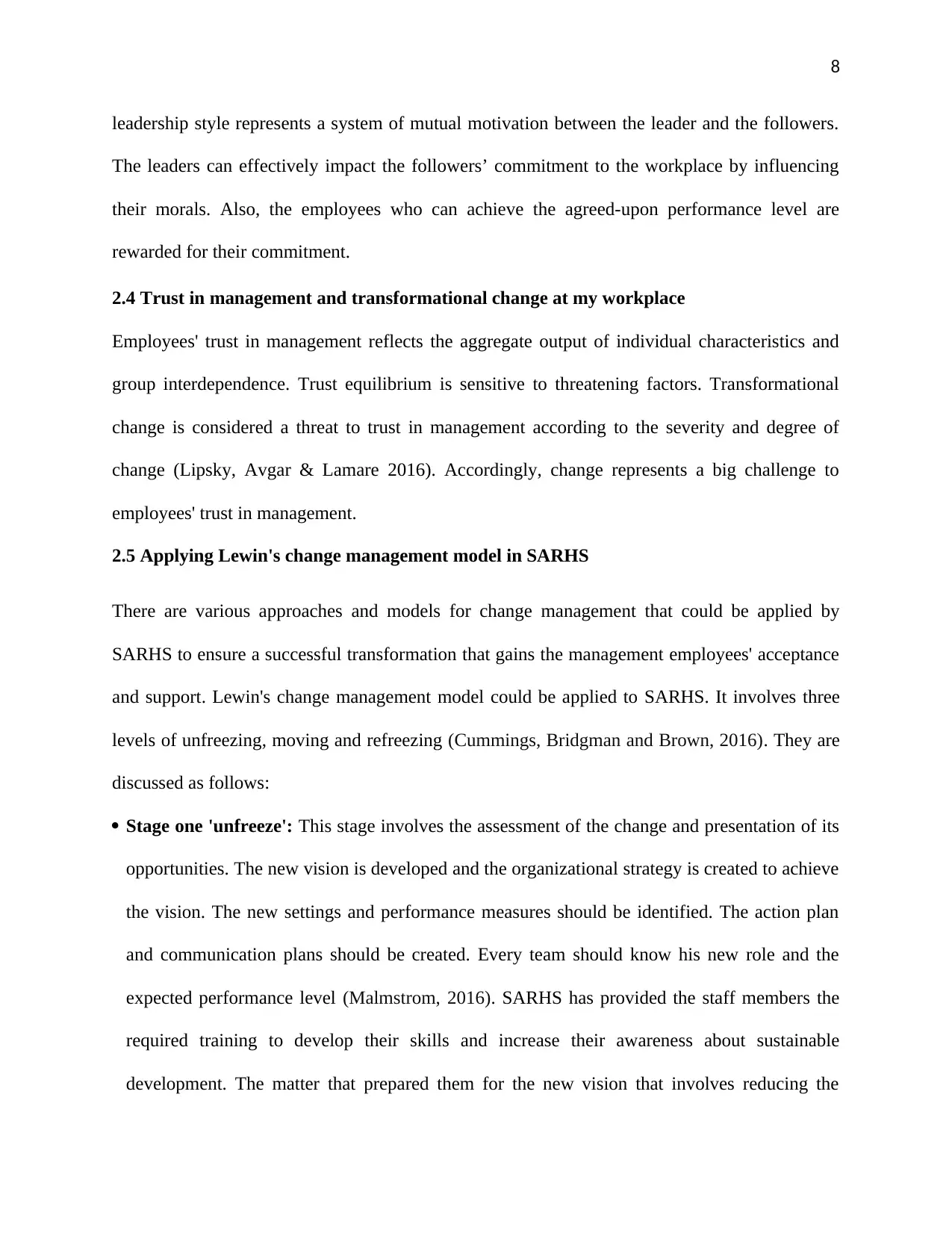
8
leadership style represents a system of mutual motivation between the leader and the followers.
The leaders can effectively impact the followers’ commitment to the workplace by influencing
their morals. Also, the employees who can achieve the agreed-upon performance level are
rewarded for their commitment.
2.4 Trust in management and transformational change at my workplace
Employees' trust in management reflects the aggregate output of individual characteristics and
group interdependence. Trust equilibrium is sensitive to threatening factors. Transformational
change is considered a threat to trust in management according to the severity and degree of
change (Lipsky, Avgar & Lamare 2016). Accordingly, change represents a big challenge to
employees' trust in management.
2.5 Applying Lewin's change management model in SARHS
There are various approaches and models for change management that could be applied by
SARHS to ensure a successful transformation that gains the management employees' acceptance
and support. Lewin's change management model could be applied to SARHS. It involves three
levels of unfreezing, moving and refreezing (Cummings, Bridgman and Brown, 2016). They are
discussed as follows:
Stage one 'unfreeze': This stage involves the assessment of the change and presentation of its
opportunities. The new vision is developed and the organizational strategy is created to achieve
the vision. The new settings and performance measures should be identified. The action plan
and communication plans should be created. Every team should know his new role and the
expected performance level (Malmstrom, 2016). SARHS has provided the staff members the
required training to develop their skills and increase their awareness about sustainable
development. The matter that prepared them for the new vision that involves reducing the
leadership style represents a system of mutual motivation between the leader and the followers.
The leaders can effectively impact the followers’ commitment to the workplace by influencing
their morals. Also, the employees who can achieve the agreed-upon performance level are
rewarded for their commitment.
2.4 Trust in management and transformational change at my workplace
Employees' trust in management reflects the aggregate output of individual characteristics and
group interdependence. Trust equilibrium is sensitive to threatening factors. Transformational
change is considered a threat to trust in management according to the severity and degree of
change (Lipsky, Avgar & Lamare 2016). Accordingly, change represents a big challenge to
employees' trust in management.
2.5 Applying Lewin's change management model in SARHS
There are various approaches and models for change management that could be applied by
SARHS to ensure a successful transformation that gains the management employees' acceptance
and support. Lewin's change management model could be applied to SARHS. It involves three
levels of unfreezing, moving and refreezing (Cummings, Bridgman and Brown, 2016). They are
discussed as follows:
Stage one 'unfreeze': This stage involves the assessment of the change and presentation of its
opportunities. The new vision is developed and the organizational strategy is created to achieve
the vision. The new settings and performance measures should be identified. The action plan
and communication plans should be created. Every team should know his new role and the
expected performance level (Malmstrom, 2016). SARHS has provided the staff members the
required training to develop their skills and increase their awareness about sustainable
development. The matter that prepared them for the new vision that involves reducing the
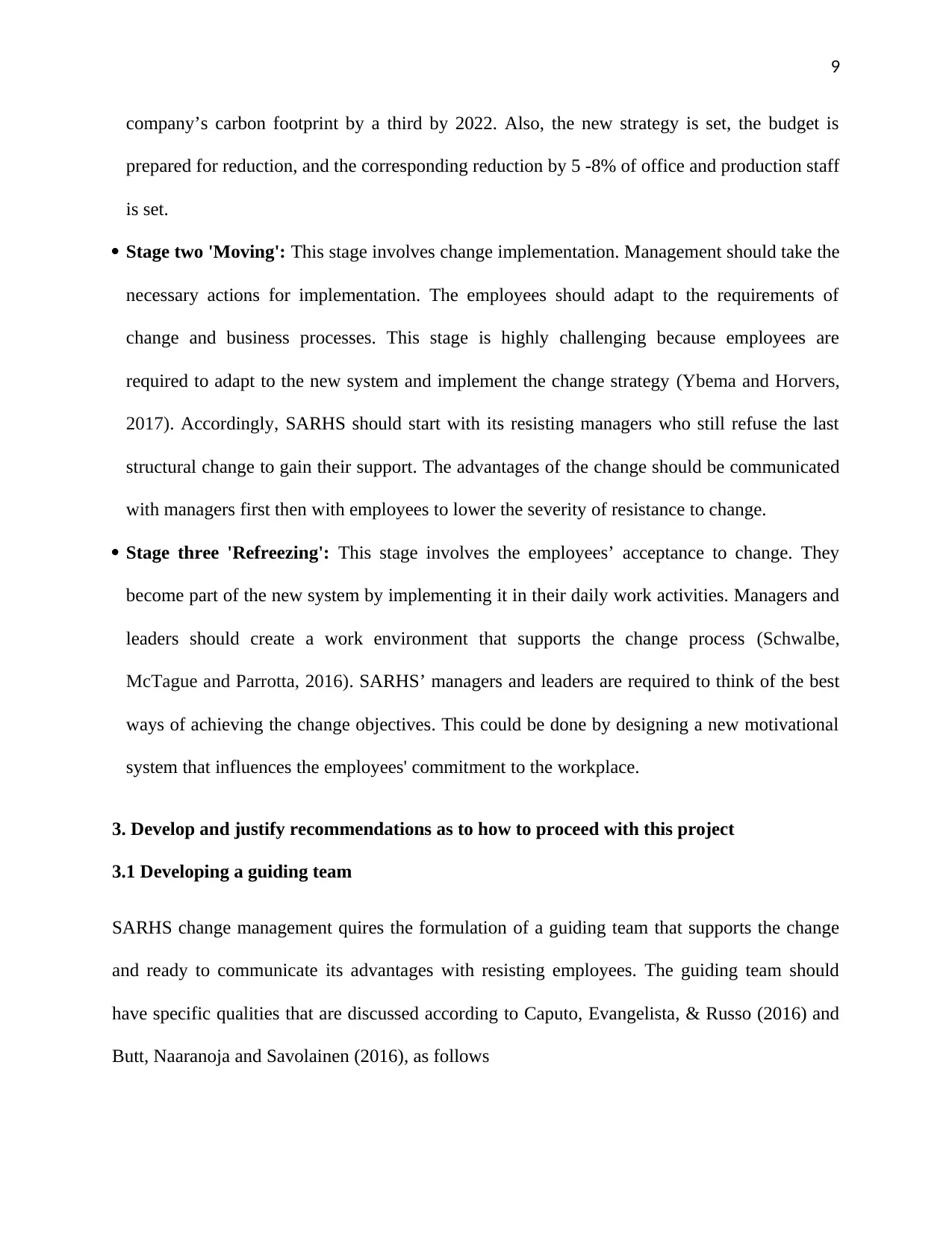
9
company’s carbon footprint by a third by 2022. Also, the new strategy is set, the budget is
prepared for reduction, and the corresponding reduction by 5 -8% of office and production staff
is set.
Stage two 'Moving': This stage involves change implementation. Management should take the
necessary actions for implementation. The employees should adapt to the requirements of
change and business processes. This stage is highly challenging because employees are
required to adapt to the new system and implement the change strategy (Ybema and Horvers,
2017). Accordingly, SARHS should start with its resisting managers who still refuse the last
structural change to gain their support. The advantages of the change should be communicated
with managers first then with employees to lower the severity of resistance to change.
Stage three 'Refreezing': This stage involves the employees’ acceptance to change. They
become part of the new system by implementing it in their daily work activities. Managers and
leaders should create a work environment that supports the change process (Schwalbe,
McTague and Parrotta, 2016). SARHS’ managers and leaders are required to think of the best
ways of achieving the change objectives. This could be done by designing a new motivational
system that influences the employees' commitment to the workplace.
3. Develop and justify recommendations as to how to proceed with this project
3.1 Developing a guiding team
SARHS change management quires the formulation of a guiding team that supports the change
and ready to communicate its advantages with resisting employees. The guiding team should
have specific qualities that are discussed according to Caputo, Evangelista, & Russo (2016) and
Butt, Naaranoja and Savolainen (2016), as follows
company’s carbon footprint by a third by 2022. Also, the new strategy is set, the budget is
prepared for reduction, and the corresponding reduction by 5 -8% of office and production staff
is set.
Stage two 'Moving': This stage involves change implementation. Management should take the
necessary actions for implementation. The employees should adapt to the requirements of
change and business processes. This stage is highly challenging because employees are
required to adapt to the new system and implement the change strategy (Ybema and Horvers,
2017). Accordingly, SARHS should start with its resisting managers who still refuse the last
structural change to gain their support. The advantages of the change should be communicated
with managers first then with employees to lower the severity of resistance to change.
Stage three 'Refreezing': This stage involves the employees’ acceptance to change. They
become part of the new system by implementing it in their daily work activities. Managers and
leaders should create a work environment that supports the change process (Schwalbe,
McTague and Parrotta, 2016). SARHS’ managers and leaders are required to think of the best
ways of achieving the change objectives. This could be done by designing a new motivational
system that influences the employees' commitment to the workplace.
3. Develop and justify recommendations as to how to proceed with this project
3.1 Developing a guiding team
SARHS change management quires the formulation of a guiding team that supports the change
and ready to communicate its advantages with resisting employees. The guiding team should
have specific qualities that are discussed according to Caputo, Evangelista, & Russo (2016) and
Butt, Naaranoja and Savolainen (2016), as follows
Secure Best Marks with AI Grader
Need help grading? Try our AI Grader for instant feedback on your assignments.
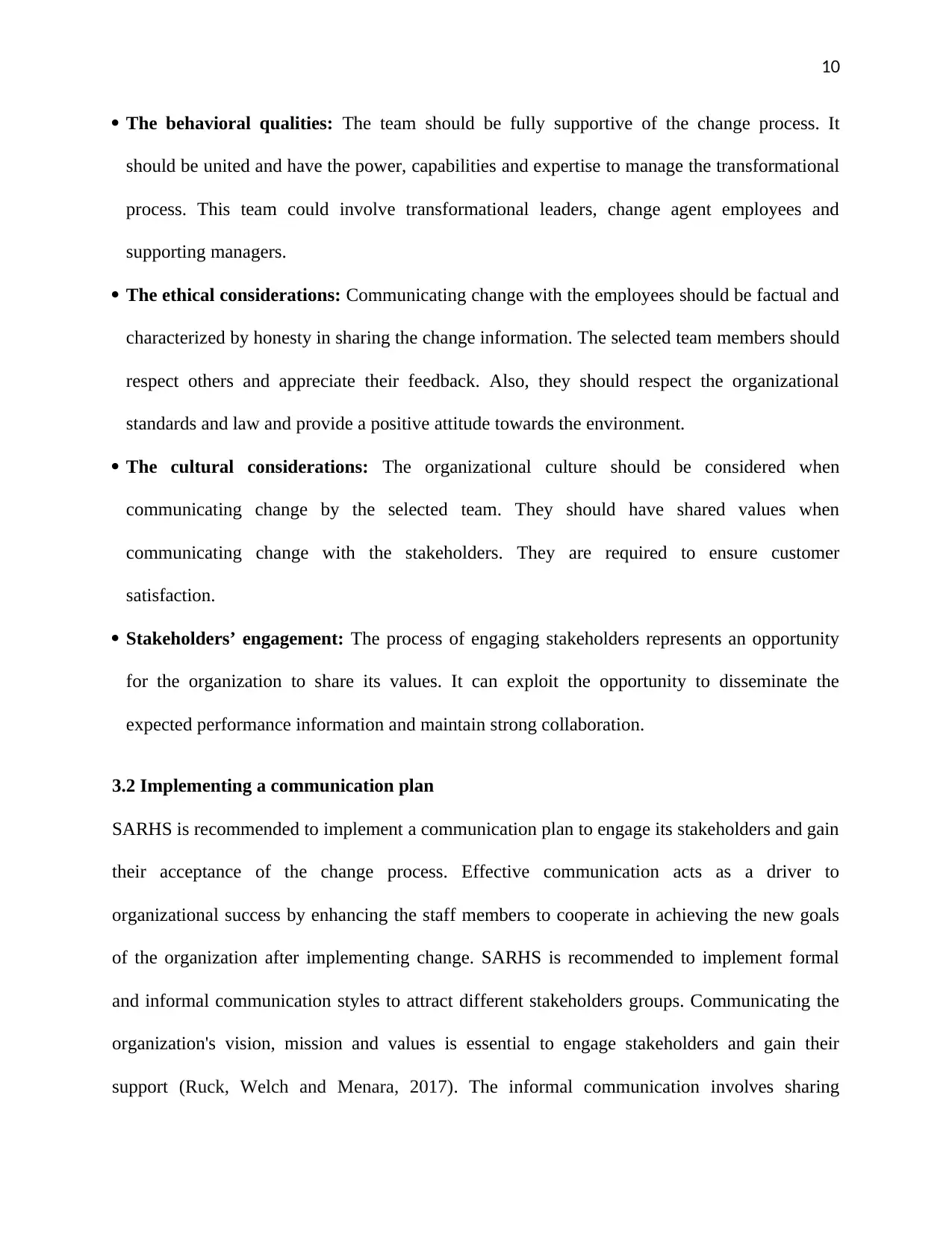
10
The behavioral qualities: The team should be fully supportive of the change process. It
should be united and have the power, capabilities and expertise to manage the transformational
process. This team could involve transformational leaders, change agent employees and
supporting managers.
The ethical considerations: Communicating change with the employees should be factual and
characterized by honesty in sharing the change information. The selected team members should
respect others and appreciate their feedback. Also, they should respect the organizational
standards and law and provide a positive attitude towards the environment.
The cultural considerations: The organizational culture should be considered when
communicating change by the selected team. They should have shared values when
communicating change with the stakeholders. They are required to ensure customer
satisfaction.
Stakeholders’ engagement: The process of engaging stakeholders represents an opportunity
for the organization to share its values. It can exploit the opportunity to disseminate the
expected performance information and maintain strong collaboration.
3.2 Implementing a communication plan
SARHS is recommended to implement a communication plan to engage its stakeholders and gain
their acceptance of the change process. Effective communication acts as a driver to
organizational success by enhancing the staff members to cooperate in achieving the new goals
of the organization after implementing change. SARHS is recommended to implement formal
and informal communication styles to attract different stakeholders groups. Communicating the
organization's vision, mission and values is essential to engage stakeholders and gain their
support (Ruck, Welch and Menara, 2017). The informal communication involves sharing
The behavioral qualities: The team should be fully supportive of the change process. It
should be united and have the power, capabilities and expertise to manage the transformational
process. This team could involve transformational leaders, change agent employees and
supporting managers.
The ethical considerations: Communicating change with the employees should be factual and
characterized by honesty in sharing the change information. The selected team members should
respect others and appreciate their feedback. Also, they should respect the organizational
standards and law and provide a positive attitude towards the environment.
The cultural considerations: The organizational culture should be considered when
communicating change by the selected team. They should have shared values when
communicating change with the stakeholders. They are required to ensure customer
satisfaction.
Stakeholders’ engagement: The process of engaging stakeholders represents an opportunity
for the organization to share its values. It can exploit the opportunity to disseminate the
expected performance information and maintain strong collaboration.
3.2 Implementing a communication plan
SARHS is recommended to implement a communication plan to engage its stakeholders and gain
their acceptance of the change process. Effective communication acts as a driver to
organizational success by enhancing the staff members to cooperate in achieving the new goals
of the organization after implementing change. SARHS is recommended to implement formal
and informal communication styles to attract different stakeholders groups. Communicating the
organization's vision, mission and values is essential to engage stakeholders and gain their
support (Ruck, Welch and Menara, 2017). The informal communication involves sharing
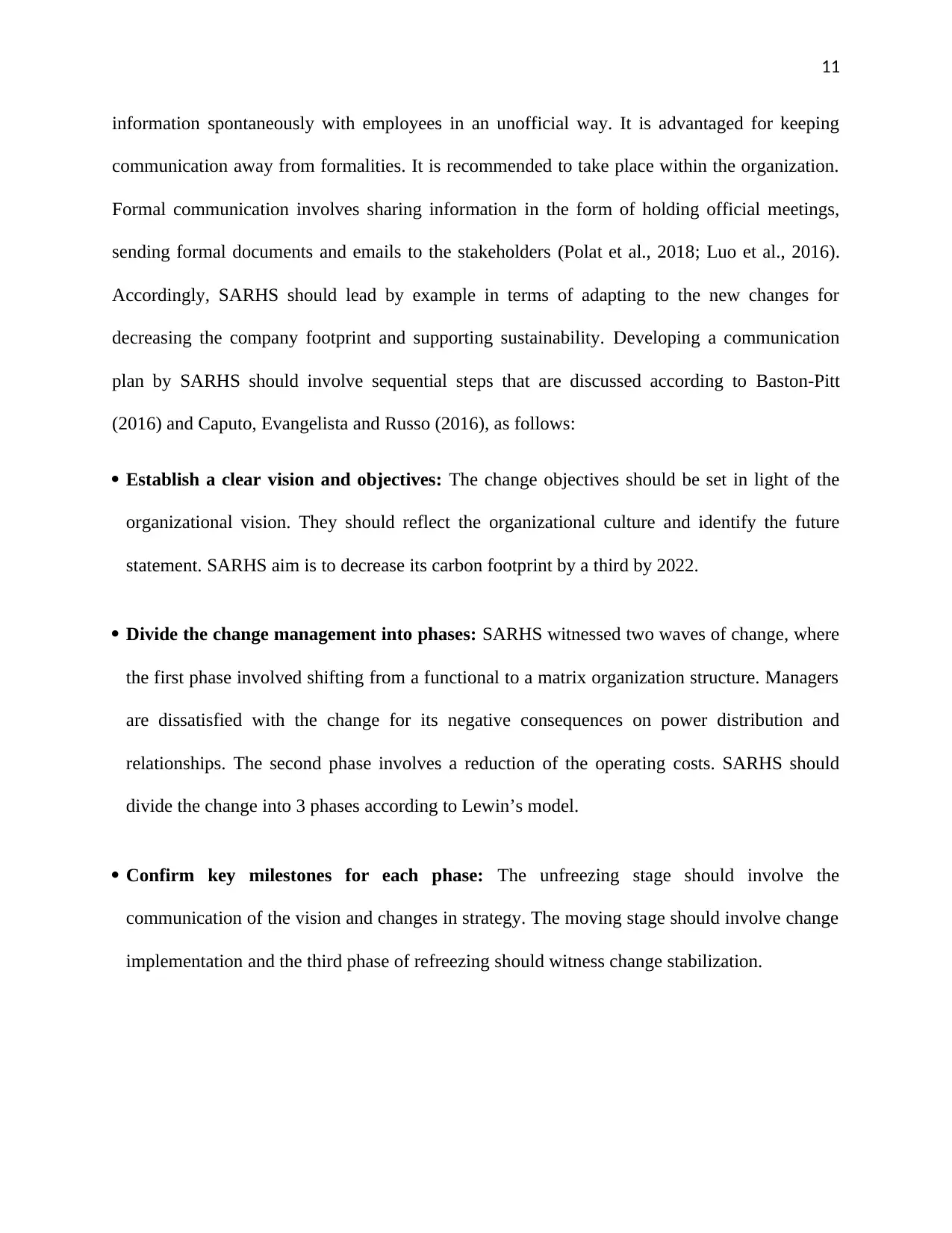
11
information spontaneously with employees in an unofficial way. It is advantaged for keeping
communication away from formalities. It is recommended to take place within the organization.
Formal communication involves sharing information in the form of holding official meetings,
sending formal documents and emails to the stakeholders (Polat et al., 2018; Luo et al., 2016).
Accordingly, SARHS should lead by example in terms of adapting to the new changes for
decreasing the company footprint and supporting sustainability. Developing a communication
plan by SARHS should involve sequential steps that are discussed according to Baston-Pitt
(2016) and Caputo, Evangelista and Russo (2016), as follows:
Establish a clear vision and objectives: The change objectives should be set in light of the
organizational vision. They should reflect the organizational culture and identify the future
statement. SARHS aim is to decrease its carbon footprint by a third by 2022.
Divide the change management into phases: SARHS witnessed two waves of change, where
the first phase involved shifting from a functional to a matrix organization structure. Managers
are dissatisfied with the change for its negative consequences on power distribution and
relationships. The second phase involves a reduction of the operating costs. SARHS should
divide the change into 3 phases according to Lewin’s model.
Confirm key milestones for each phase: The unfreezing stage should involve the
communication of the vision and changes in strategy. The moving stage should involve change
implementation and the third phase of refreezing should witness change stabilization.
information spontaneously with employees in an unofficial way. It is advantaged for keeping
communication away from formalities. It is recommended to take place within the organization.
Formal communication involves sharing information in the form of holding official meetings,
sending formal documents and emails to the stakeholders (Polat et al., 2018; Luo et al., 2016).
Accordingly, SARHS should lead by example in terms of adapting to the new changes for
decreasing the company footprint and supporting sustainability. Developing a communication
plan by SARHS should involve sequential steps that are discussed according to Baston-Pitt
(2016) and Caputo, Evangelista and Russo (2016), as follows:
Establish a clear vision and objectives: The change objectives should be set in light of the
organizational vision. They should reflect the organizational culture and identify the future
statement. SARHS aim is to decrease its carbon footprint by a third by 2022.
Divide the change management into phases: SARHS witnessed two waves of change, where
the first phase involved shifting from a functional to a matrix organization structure. Managers
are dissatisfied with the change for its negative consequences on power distribution and
relationships. The second phase involves a reduction of the operating costs. SARHS should
divide the change into 3 phases according to Lewin’s model.
Confirm key milestones for each phase: The unfreezing stage should involve the
communication of the vision and changes in strategy. The moving stage should involve change
implementation and the third phase of refreezing should witness change stabilization.
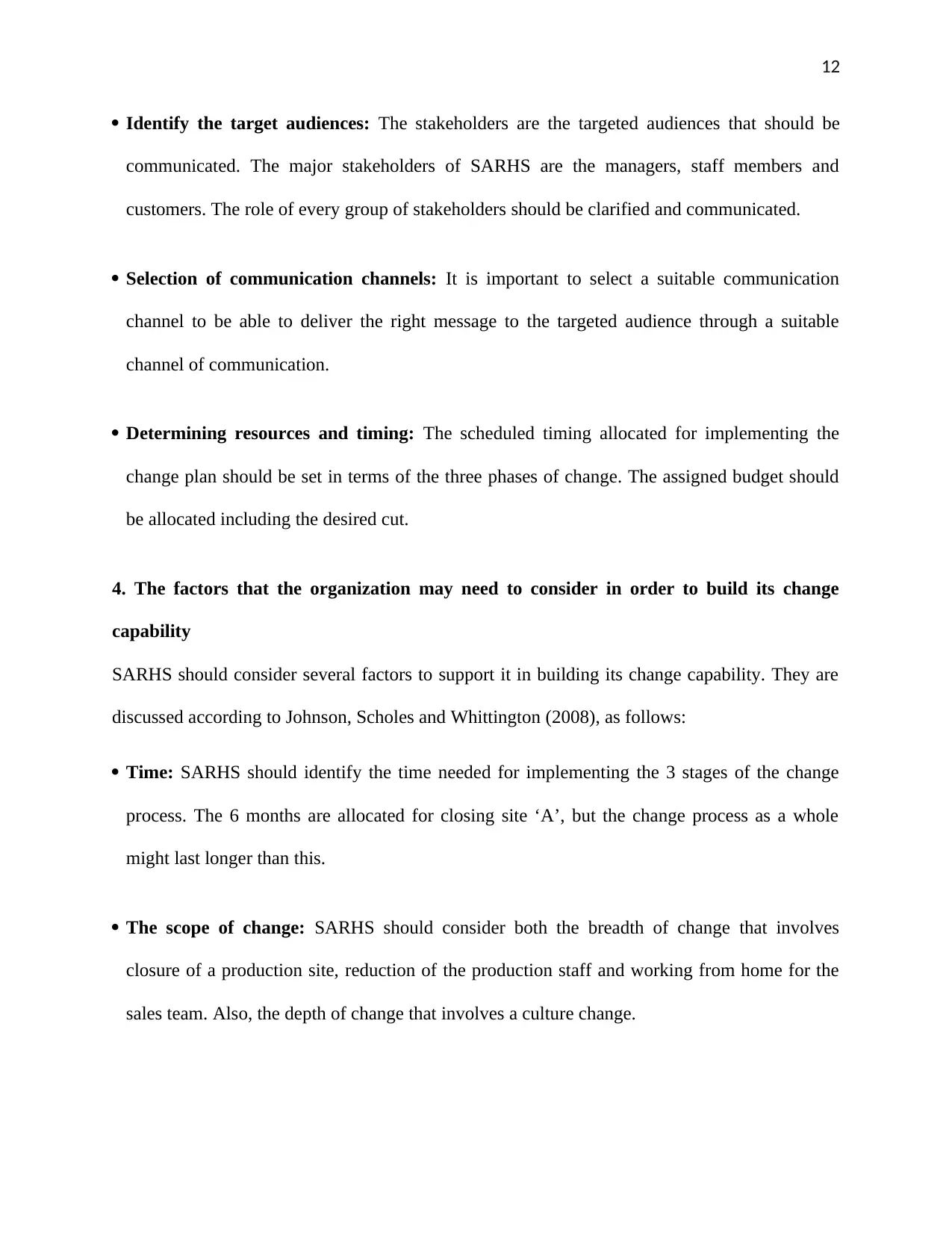
12
Identify the target audiences: The stakeholders are the targeted audiences that should be
communicated. The major stakeholders of SARHS are the managers, staff members and
customers. The role of every group of stakeholders should be clarified and communicated.
Selection of communication channels: It is important to select a suitable communication
channel to be able to deliver the right message to the targeted audience through a suitable
channel of communication.
Determining resources and timing: The scheduled timing allocated for implementing the
change plan should be set in terms of the three phases of change. The assigned budget should
be allocated including the desired cut.
4. The factors that the organization may need to consider in order to build its change
capability
SARHS should consider several factors to support it in building its change capability. They are
discussed according to Johnson, Scholes and Whittington (2008), as follows:
Time: SARHS should identify the time needed for implementing the 3 stages of the change
process. The 6 months are allocated for closing site ‘A’, but the change process as a whole
might last longer than this.
The scope of change: SARHS should consider both the breadth of change that involves
closure of a production site, reduction of the production staff and working from home for the
sales team. Also, the depth of change that involves a culture change.
Identify the target audiences: The stakeholders are the targeted audiences that should be
communicated. The major stakeholders of SARHS are the managers, staff members and
customers. The role of every group of stakeholders should be clarified and communicated.
Selection of communication channels: It is important to select a suitable communication
channel to be able to deliver the right message to the targeted audience through a suitable
channel of communication.
Determining resources and timing: The scheduled timing allocated for implementing the
change plan should be set in terms of the three phases of change. The assigned budget should
be allocated including the desired cut.
4. The factors that the organization may need to consider in order to build its change
capability
SARHS should consider several factors to support it in building its change capability. They are
discussed according to Johnson, Scholes and Whittington (2008), as follows:
Time: SARHS should identify the time needed for implementing the 3 stages of the change
process. The 6 months are allocated for closing site ‘A’, but the change process as a whole
might last longer than this.
The scope of change: SARHS should consider both the breadth of change that involves
closure of a production site, reduction of the production staff and working from home for the
sales team. Also, the depth of change that involves a culture change.
Paraphrase This Document
Need a fresh take? Get an instant paraphrase of this document with our AI Paraphraser
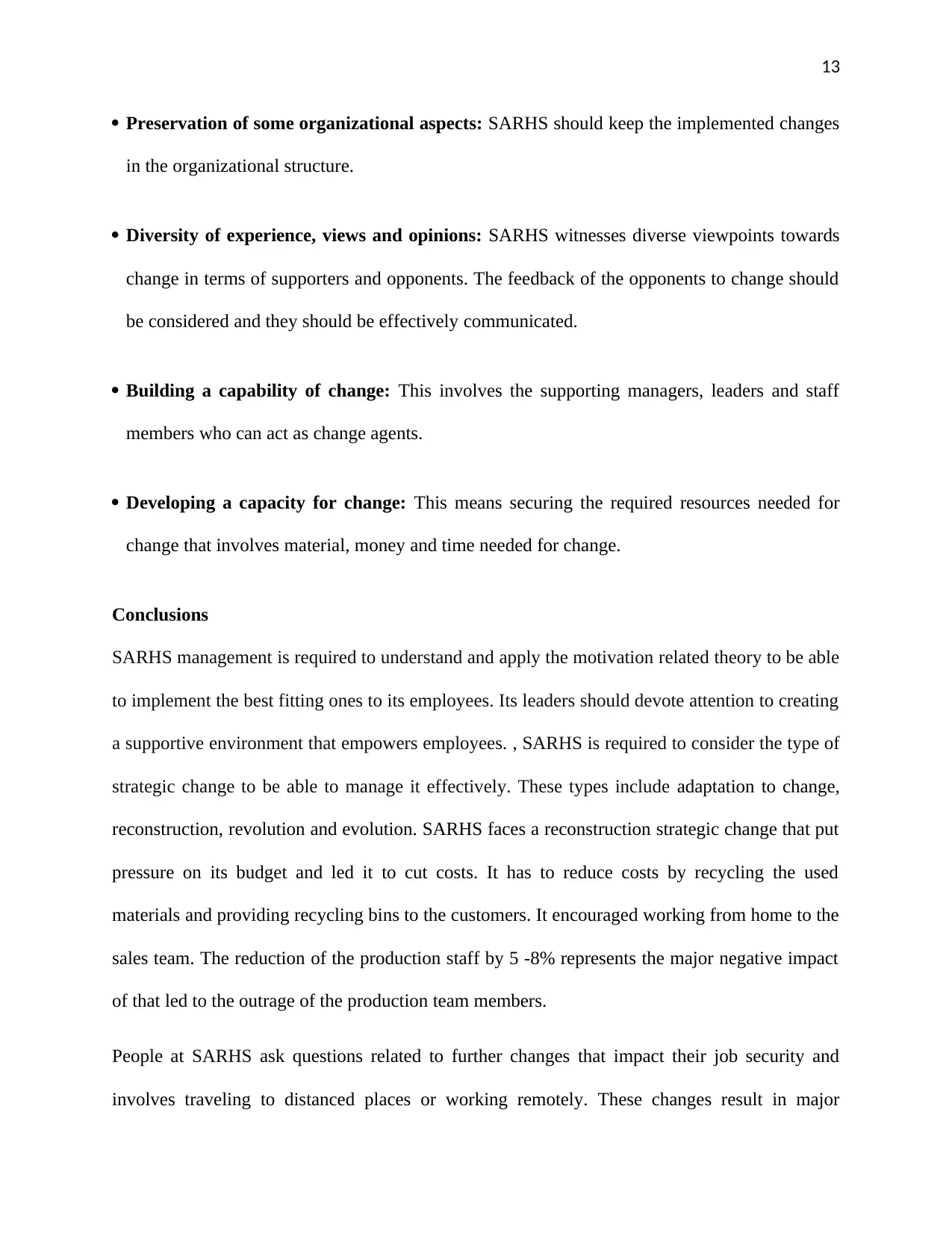
13
Preservation of some organizational aspects: SARHS should keep the implemented changes
in the organizational structure.
Diversity of experience, views and opinions: SARHS witnesses diverse viewpoints towards
change in terms of supporters and opponents. The feedback of the opponents to change should
be considered and they should be effectively communicated.
Building a capability of change: This involves the supporting managers, leaders and staff
members who can act as change agents.
Developing a capacity for change: This means securing the required resources needed for
change that involves material, money and time needed for change.
Conclusions
SARHS management is required to understand and apply the motivation related theory to be able
to implement the best fitting ones to its employees. Its leaders should devote attention to creating
a supportive environment that empowers employees. , SARHS is required to consider the type of
strategic change to be able to manage it effectively. These types include adaptation to change,
reconstruction, revolution and evolution. SARHS faces a reconstruction strategic change that put
pressure on its budget and led it to cut costs. It has to reduce costs by recycling the used
materials and providing recycling bins to the customers. It encouraged working from home to the
sales team. The reduction of the production staff by 5 -8% represents the major negative impact
of that led to the outrage of the production team members.
People at SARHS ask questions related to further changes that impact their job security and
involves traveling to distanced places or working remotely. These changes result in major
Preservation of some organizational aspects: SARHS should keep the implemented changes
in the organizational structure.
Diversity of experience, views and opinions: SARHS witnesses diverse viewpoints towards
change in terms of supporters and opponents. The feedback of the opponents to change should
be considered and they should be effectively communicated.
Building a capability of change: This involves the supporting managers, leaders and staff
members who can act as change agents.
Developing a capacity for change: This means securing the required resources needed for
change that involves material, money and time needed for change.
Conclusions
SARHS management is required to understand and apply the motivation related theory to be able
to implement the best fitting ones to its employees. Its leaders should devote attention to creating
a supportive environment that empowers employees. , SARHS is required to consider the type of
strategic change to be able to manage it effectively. These types include adaptation to change,
reconstruction, revolution and evolution. SARHS faces a reconstruction strategic change that put
pressure on its budget and led it to cut costs. It has to reduce costs by recycling the used
materials and providing recycling bins to the customers. It encouraged working from home to the
sales team. The reduction of the production staff by 5 -8% represents the major negative impact
of that led to the outrage of the production team members.
People at SARHS ask questions related to further changes that impact their job security and
involves traveling to distanced places or working remotely. These changes result in major
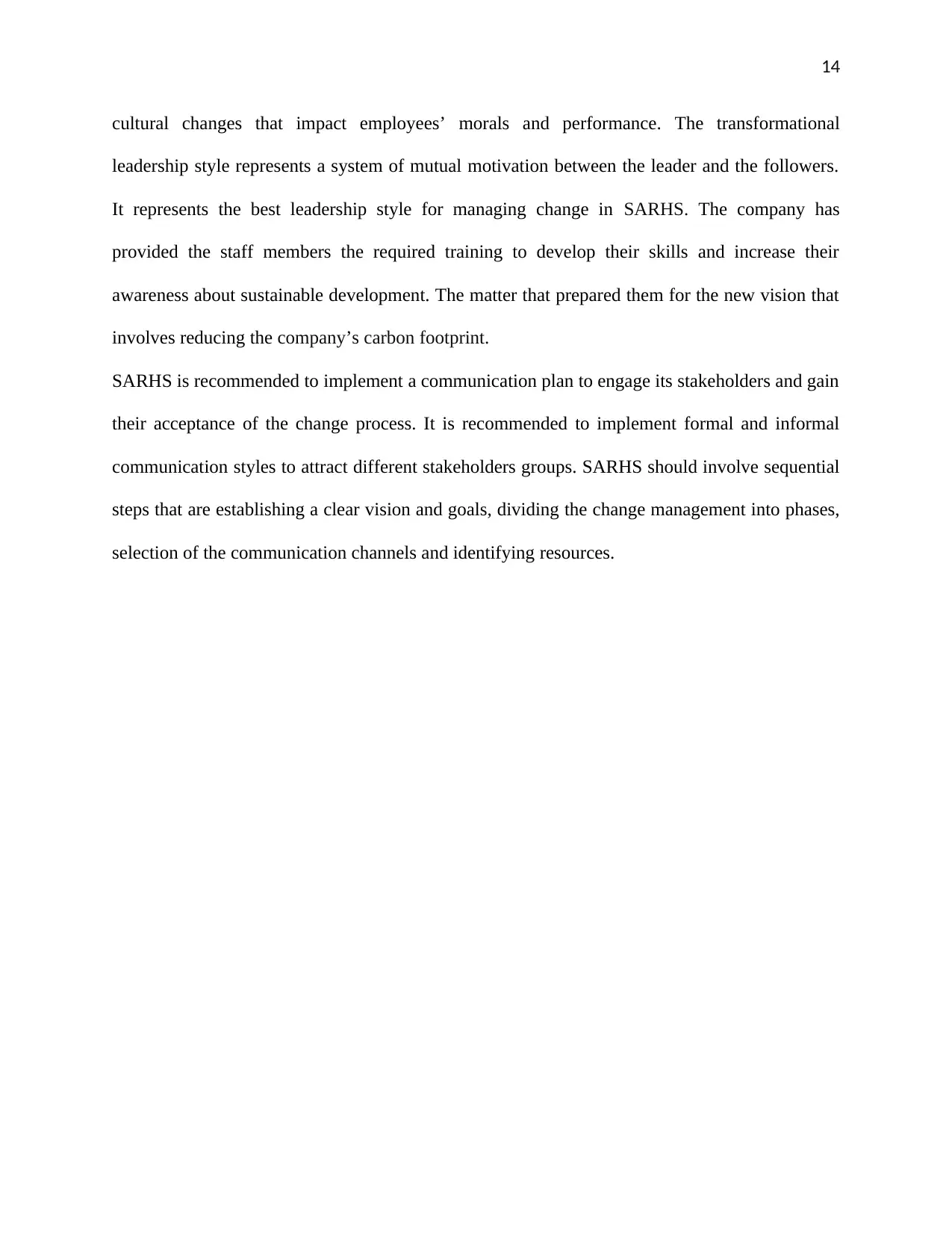
14
cultural changes that impact employees’ morals and performance. The transformational
leadership style represents a system of mutual motivation between the leader and the followers.
It represents the best leadership style for managing change in SARHS. The company has
provided the staff members the required training to develop their skills and increase their
awareness about sustainable development. The matter that prepared them for the new vision that
involves reducing the company’s carbon footprint.
SARHS is recommended to implement a communication plan to engage its stakeholders and gain
their acceptance of the change process. It is recommended to implement formal and informal
communication styles to attract different stakeholders groups. SARHS should involve sequential
steps that are establishing a clear vision and goals, dividing the change management into phases,
selection of the communication channels and identifying resources.
cultural changes that impact employees’ morals and performance. The transformational
leadership style represents a system of mutual motivation between the leader and the followers.
It represents the best leadership style for managing change in SARHS. The company has
provided the staff members the required training to develop their skills and increase their
awareness about sustainable development. The matter that prepared them for the new vision that
involves reducing the company’s carbon footprint.
SARHS is recommended to implement a communication plan to engage its stakeholders and gain
their acceptance of the change process. It is recommended to implement formal and informal
communication styles to attract different stakeholders groups. SARHS should involve sequential
steps that are establishing a clear vision and goals, dividing the change management into phases,
selection of the communication channels and identifying resources.
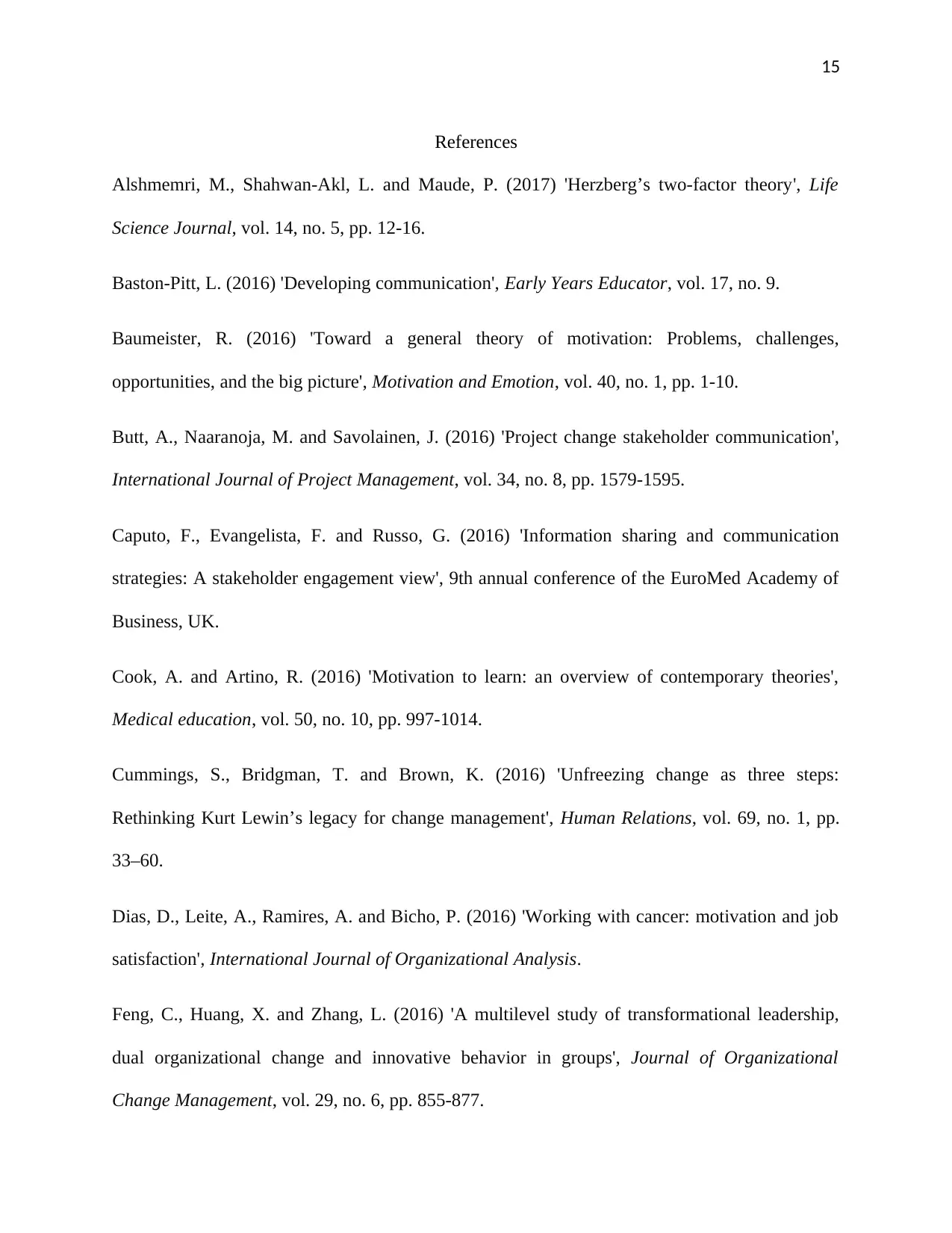
15
References
Alshmemri, M., Shahwan-Akl, L. and Maude, P. (2017) 'Herzberg’s two-factor theory', Life
Science Journal, vol. 14, no. 5, pp. 12-16.
Baston-Pitt, L. (2016) 'Developing communication', Early Years Educator, vol. 17, no. 9.
Baumeister, R. (2016) 'Toward a general theory of motivation: Problems, challenges,
opportunities, and the big picture', Motivation and Emotion, vol. 40, no. 1, pp. 1-10.
Butt, A., Naaranoja, M. and Savolainen, J. (2016) 'Project change stakeholder communication',
International Journal of Project Management, vol. 34, no. 8, pp. 1579-1595.
Caputo, F., Evangelista, F. and Russo, G. (2016) 'Information sharing and communication
strategies: A stakeholder engagement view', 9th annual conference of the EuroMed Academy of
Business, UK.
Cook, A. and Artino, R. (2016) 'Motivation to learn: an overview of contemporary theories',
Medical education, vol. 50, no. 10, pp. 997-1014.
Cummings, S., Bridgman, T. and Brown, K. (2016) 'Unfreezing change as three steps:
Rethinking Kurt Lewin’s legacy for change management', Human Relations, vol. 69, no. 1, pp.
33–60.
Dias, D., Leite, A., Ramires, A. and Bicho, P. (2016) 'Working with cancer: motivation and job
satisfaction', International Journal of Organizational Analysis.
Feng, C., Huang, X. and Zhang, L. (2016) 'A multilevel study of transformational leadership,
dual organizational change and innovative behavior in groups', Journal of Organizational
Change Management, vol. 29, no. 6, pp. 855-877.
References
Alshmemri, M., Shahwan-Akl, L. and Maude, P. (2017) 'Herzberg’s two-factor theory', Life
Science Journal, vol. 14, no. 5, pp. 12-16.
Baston-Pitt, L. (2016) 'Developing communication', Early Years Educator, vol. 17, no. 9.
Baumeister, R. (2016) 'Toward a general theory of motivation: Problems, challenges,
opportunities, and the big picture', Motivation and Emotion, vol. 40, no. 1, pp. 1-10.
Butt, A., Naaranoja, M. and Savolainen, J. (2016) 'Project change stakeholder communication',
International Journal of Project Management, vol. 34, no. 8, pp. 1579-1595.
Caputo, F., Evangelista, F. and Russo, G. (2016) 'Information sharing and communication
strategies: A stakeholder engagement view', 9th annual conference of the EuroMed Academy of
Business, UK.
Cook, A. and Artino, R. (2016) 'Motivation to learn: an overview of contemporary theories',
Medical education, vol. 50, no. 10, pp. 997-1014.
Cummings, S., Bridgman, T. and Brown, K. (2016) 'Unfreezing change as three steps:
Rethinking Kurt Lewin’s legacy for change management', Human Relations, vol. 69, no. 1, pp.
33–60.
Dias, D., Leite, A., Ramires, A. and Bicho, P. (2016) 'Working with cancer: motivation and job
satisfaction', International Journal of Organizational Analysis.
Feng, C., Huang, X. and Zhang, L. (2016) 'A multilevel study of transformational leadership,
dual organizational change and innovative behavior in groups', Journal of Organizational
Change Management, vol. 29, no. 6, pp. 855-877.
Secure Best Marks with AI Grader
Need help grading? Try our AI Grader for instant feedback on your assignments.
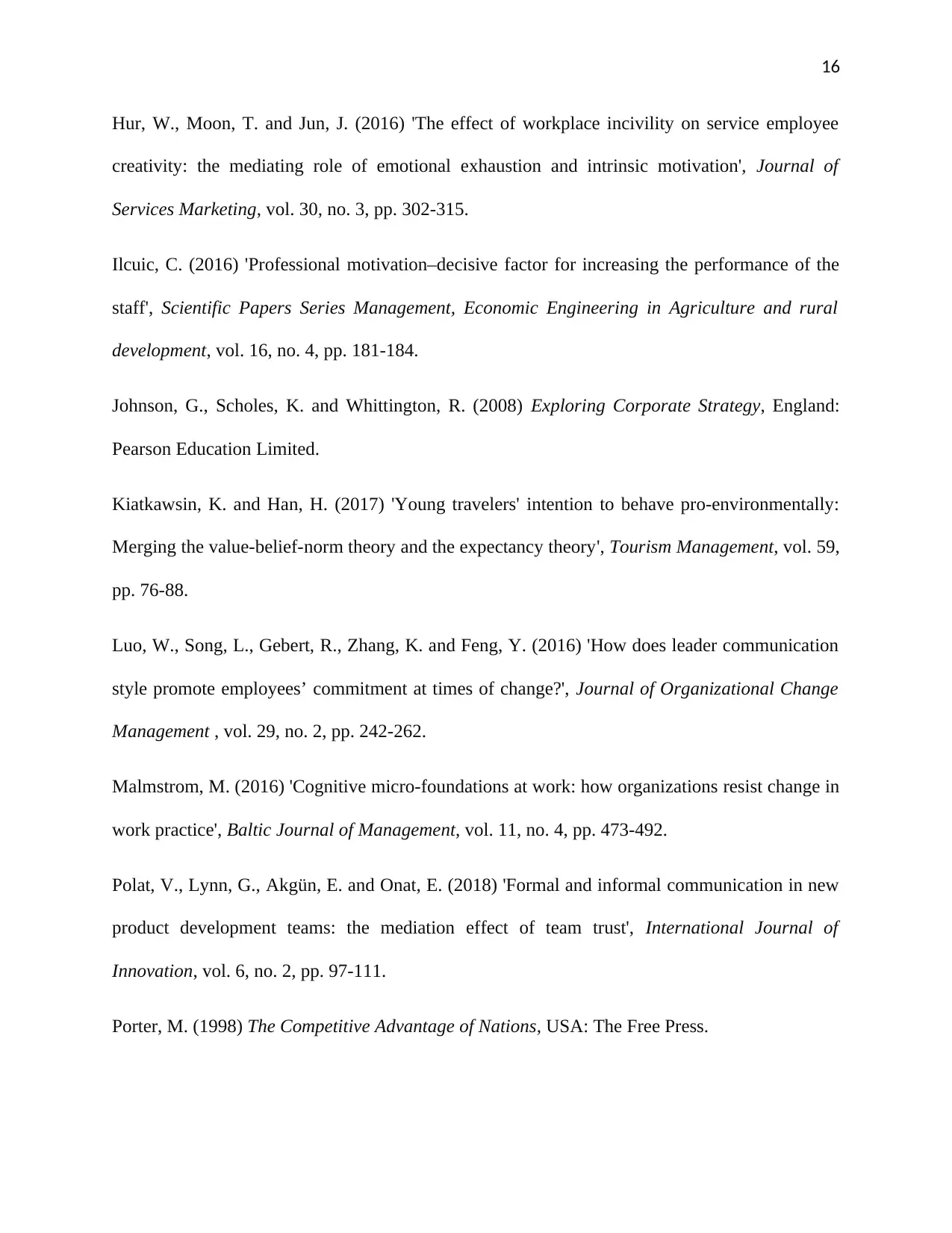
16
Hur, W., Moon, T. and Jun, J. (2016) 'The effect of workplace incivility on service employee
creativity: the mediating role of emotional exhaustion and intrinsic motivation', Journal of
Services Marketing, vol. 30, no. 3, pp. 302-315.
Ilcuic, C. (2016) 'Professional motivation–decisive factor for increasing the performance of the
staff', Scientific Papers Series Management, Economic Engineering in Agriculture and rural
development, vol. 16, no. 4, pp. 181-184.
Johnson, G., Scholes, K. and Whittington, R. (2008) Exploring Corporate Strategy, England:
Pearson Education Limited.
Kiatkawsin, K. and Han, H. (2017) 'Young travelers' intention to behave pro-environmentally:
Merging the value-belief-norm theory and the expectancy theory', Tourism Management, vol. 59,
pp. 76-88.
Luo, W., Song, L., Gebert, R., Zhang, K. and Feng, Y. (2016) 'How does leader communication
style promote employees’ commitment at times of change?', Journal of Organizational Change
Management , vol. 29, no. 2, pp. 242-262.
Malmstrom, M. (2016) 'Cognitive micro-foundations at work: how organizations resist change in
work practice', Baltic Journal of Management, vol. 11, no. 4, pp. 473-492.
Polat, V., Lynn, G., Akgün, E. and Onat, E. (2018) 'Formal and informal communication in new
product development teams: the mediation effect of team trust', International Journal of
Innovation, vol. 6, no. 2, pp. 97-111.
Porter, M. (1998) The Competitive Advantage of Nations, USA: The Free Press.
Hur, W., Moon, T. and Jun, J. (2016) 'The effect of workplace incivility on service employee
creativity: the mediating role of emotional exhaustion and intrinsic motivation', Journal of
Services Marketing, vol. 30, no. 3, pp. 302-315.
Ilcuic, C. (2016) 'Professional motivation–decisive factor for increasing the performance of the
staff', Scientific Papers Series Management, Economic Engineering in Agriculture and rural
development, vol. 16, no. 4, pp. 181-184.
Johnson, G., Scholes, K. and Whittington, R. (2008) Exploring Corporate Strategy, England:
Pearson Education Limited.
Kiatkawsin, K. and Han, H. (2017) 'Young travelers' intention to behave pro-environmentally:
Merging the value-belief-norm theory and the expectancy theory', Tourism Management, vol. 59,
pp. 76-88.
Luo, W., Song, L., Gebert, R., Zhang, K. and Feng, Y. (2016) 'How does leader communication
style promote employees’ commitment at times of change?', Journal of Organizational Change
Management , vol. 29, no. 2, pp. 242-262.
Malmstrom, M. (2016) 'Cognitive micro-foundations at work: how organizations resist change in
work practice', Baltic Journal of Management, vol. 11, no. 4, pp. 473-492.
Polat, V., Lynn, G., Akgün, E. and Onat, E. (2018) 'Formal and informal communication in new
product development teams: the mediation effect of team trust', International Journal of
Innovation, vol. 6, no. 2, pp. 97-111.
Porter, M. (1998) The Competitive Advantage of Nations, USA: The Free Press.
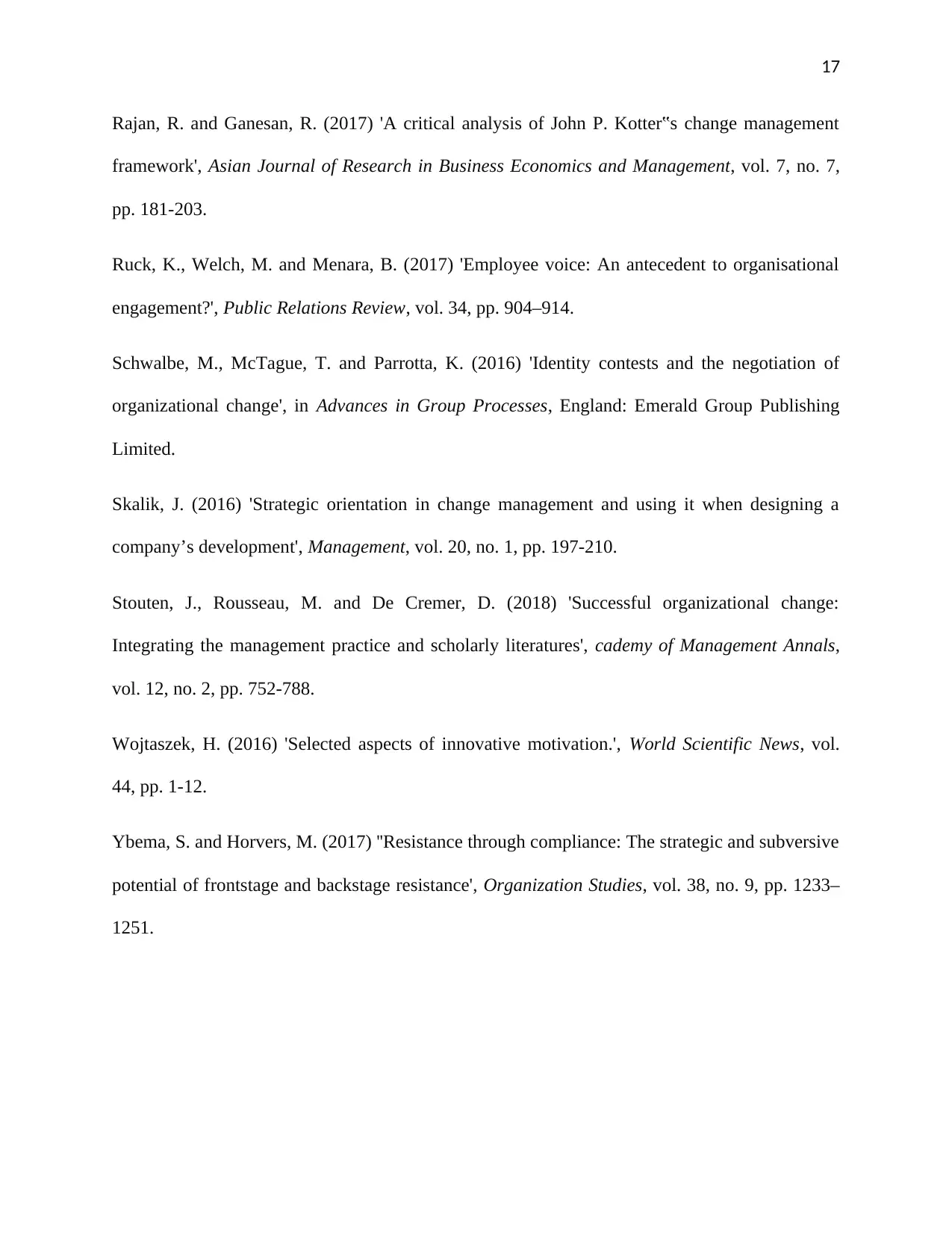
17
Rajan, R. and Ganesan, R. (2017) 'A critical analysis of John P. Kotter‟s change management
framework', Asian Journal of Research in Business Economics and Management, vol. 7, no. 7,
pp. 181-203.
Ruck, K., Welch, M. and Menara, B. (2017) 'Employee voice: An antecedent to organisational
engagement?', Public Relations Review, vol. 34, pp. 904–914.
Schwalbe, M., McTague, T. and Parrotta, K. (2016) 'Identity contests and the negotiation of
organizational change', in Advances in Group Processes, England: Emerald Group Publishing
Limited.
Skalik, J. (2016) 'Strategic orientation in change management and using it when designing a
company’s development', Management, vol. 20, no. 1, pp. 197-210.
Stouten, J., Rousseau, M. and De Cremer, D. (2018) 'Successful organizational change:
Integrating the management practice and scholarly literatures', cademy of Management Annals,
vol. 12, no. 2, pp. 752-788.
Wojtaszek, H. (2016) 'Selected aspects of innovative motivation.', World Scientific News, vol.
44, pp. 1-12.
Ybema, S. and Horvers, M. (2017) ''Resistance through compliance: The strategic and subversive
potential of frontstage and backstage resistance', Organization Studies, vol. 38, no. 9, pp. 1233–
1251.
Rajan, R. and Ganesan, R. (2017) 'A critical analysis of John P. Kotter‟s change management
framework', Asian Journal of Research in Business Economics and Management, vol. 7, no. 7,
pp. 181-203.
Ruck, K., Welch, M. and Menara, B. (2017) 'Employee voice: An antecedent to organisational
engagement?', Public Relations Review, vol. 34, pp. 904–914.
Schwalbe, M., McTague, T. and Parrotta, K. (2016) 'Identity contests and the negotiation of
organizational change', in Advances in Group Processes, England: Emerald Group Publishing
Limited.
Skalik, J. (2016) 'Strategic orientation in change management and using it when designing a
company’s development', Management, vol. 20, no. 1, pp. 197-210.
Stouten, J., Rousseau, M. and De Cremer, D. (2018) 'Successful organizational change:
Integrating the management practice and scholarly literatures', cademy of Management Annals,
vol. 12, no. 2, pp. 752-788.
Wojtaszek, H. (2016) 'Selected aspects of innovative motivation.', World Scientific News, vol.
44, pp. 1-12.
Ybema, S. and Horvers, M. (2017) ''Resistance through compliance: The strategic and subversive
potential of frontstage and backstage resistance', Organization Studies, vol. 38, no. 9, pp. 1233–
1251.
1 out of 18
Related Documents
Your All-in-One AI-Powered Toolkit for Academic Success.
+13062052269
info@desklib.com
Available 24*7 on WhatsApp / Email
![[object Object]](/_next/static/media/star-bottom.7253800d.svg)
Unlock your academic potential
© 2024 | Zucol Services PVT LTD | All rights reserved.





